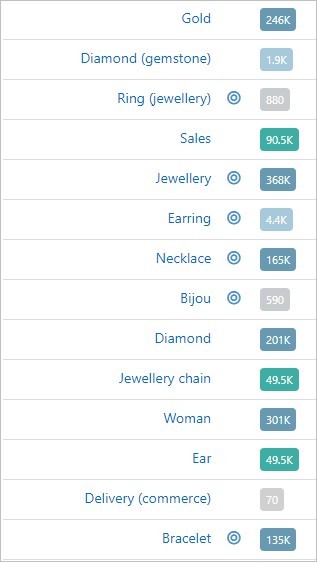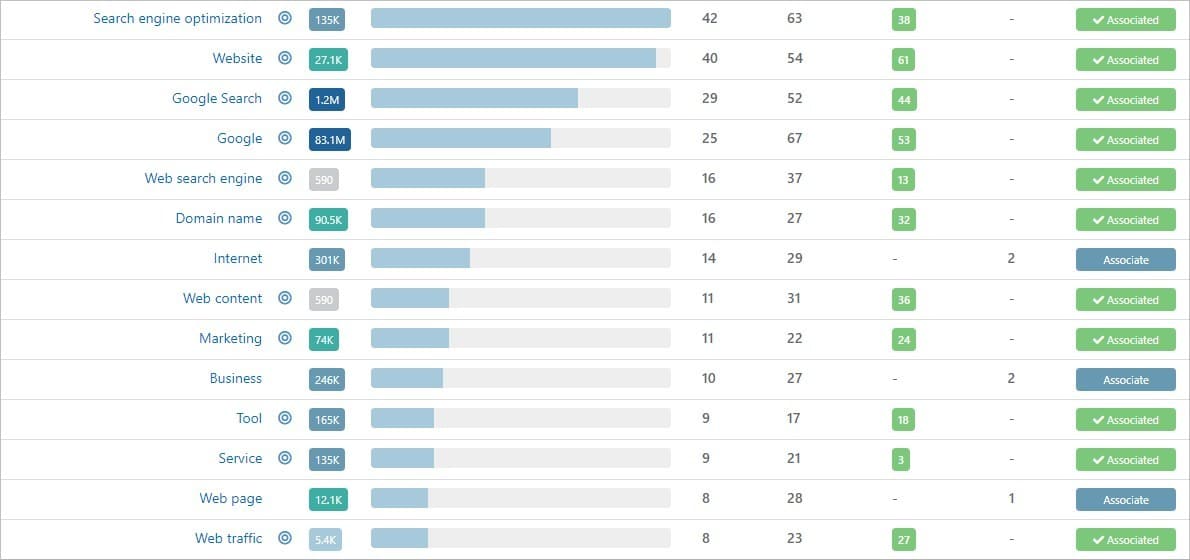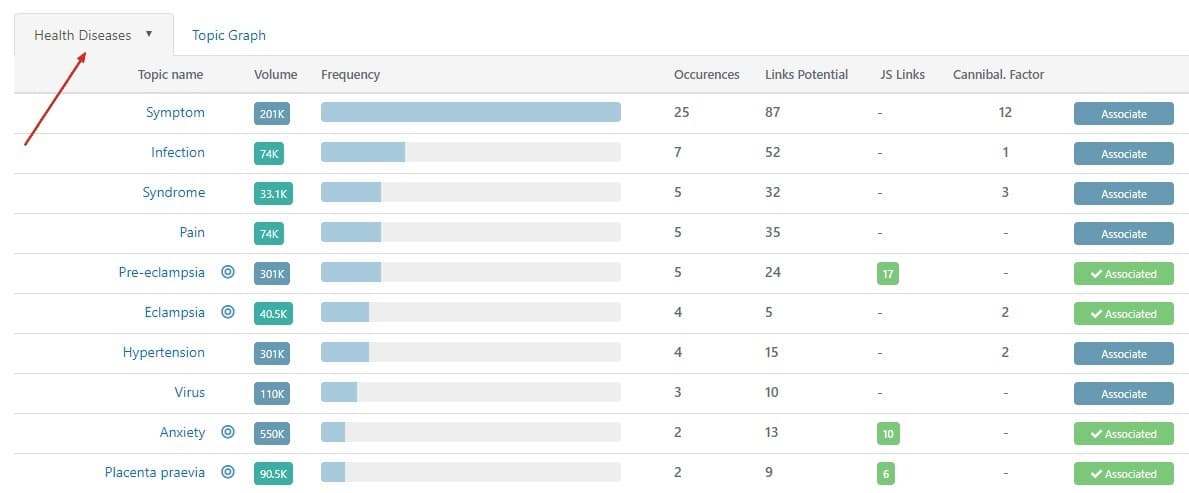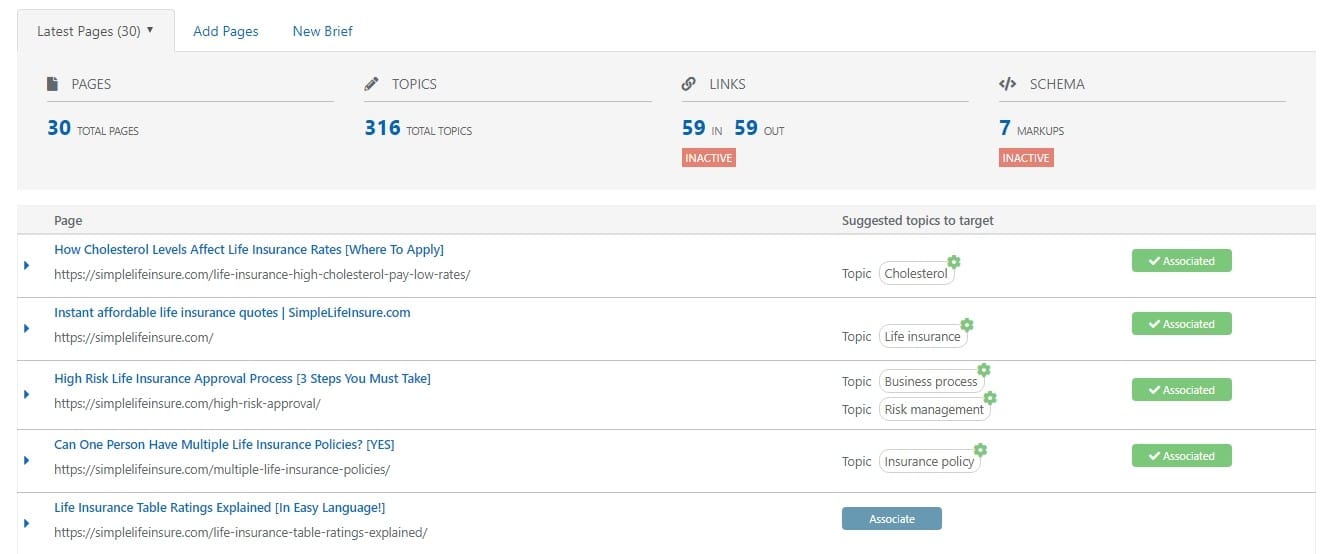Summary
To optimize for Semantic Search, you need landing pages
Here are some examples on how to select your target entities with InLinks.
Example 1: A transactional site
Let’s consider a site marketing jewellery. This site is divided into two distinct parts: costume jewellery on one side, gold jewellery on the other. We are only interested here in the gold jewellery part.
Classically, the architecture of the site would include two main categories (Costume & Gold), and in each, 4 sub-categories corresponding to the types of products sold: bracelets, rings, necklaces
The 5 main pages whose SEO performance you want to improve are only category pages:

- “Gold Jewellery” (main category)
- “Women’s Golden Bracelets” (sub-category)
- “Golden Female Necklaces” (sub-category)
- “Female Golden Rings” (sub-category)
- “Female Earrings in Gold” (sub-category)
1.1 Identify contextual entities
The first reason for identifying target entities is to determine which are the contextual entities.
In this case, the “Women” entity is contextual to the site: the
1.2 Identify characteristic entities
For each of the sub-category pages, it now becomes easy to identify the target entities that will characterize each page:
- The entity “Bracelet” for the page “Women’s Bracelets in Yellow, White or Pink Gold”
- The entity “Necklace” for the page “Women’s Necklaces in Yellow, White or Pink Gold”
- etc.
Then we decide on the target entity or entities to be associated with the main category page. There are several possibilities for this:
- Associate only the “Gold” entity, since this entity is the common feature of all products sold in this category.
- Associate the “Jewellery” entity, in a “Gold” context, with the opposite of the “Jewellery” entity in a “fashion” context, which will concern the category of Fantasy jewellery.
- Use possibilities 1) and 2) simultaneously (in particular to maximise the internal link network size).
Example 2: A semi-transactional site
Let’s now consider the website of a digital marketing agency, which offers both pages dedicated to services and a blog dedicated to web marketing.
The first step identifies the target pages whose positioning in the SERPs is to be optimized. For example, they might be following pages:
- Local SEO Consultant
- Monetizing your website
- Online Reputation Management
- E-commerce Search Engine Optimization
- SEO Audit Service
- SEO Consulting Services, SEO Audits & On-going SEO (home page)
- Why is Blogging Important for SEO?
- What is SEO?
The complete analysis of the site by InLinks will allow you to retrieve the list of all the entities covered in these pages.

In order to identify the target entities to be associated with each of the target pages listed above, we proceed in the same way as we did in example 1:
- identify the contextual entity or entities of the site (here: Search Engine Optimization)
- identify the entities that characterize each page
Here is the result:
| Target Entities | Target Pages |
| Consultant | Local SEO Consultant |
| Monetization | Monetizing your website |
| Reputation + Reputation Management | Online Reputation Management |
| E-commerce | E-commerce Search Engine Optimization |
| Audit | SEO Audit Service |
| Search Engine Optimization | SEO Consulting Services, SEO Audits & On-going SEO (home page) |
| Blog | Why is Blogging important for SEO ? |
| – | What is SEO ? |
It should be noted here that it was necessary to arbitrate between two pages: the home page and the “What is SEO? page. The choice made here corresponds to the desire to highlight the home page at the expense of a subpage.
Example 3: A blog or an informational site
In general, once the blog’s architecture has been well thought out, you can find yourself in a Wikipedia-type configuration, where each page corresponds to a target entity that characterizes it.
Let’s take the example of a blog dedicated to pregnancy. This blog will cover all the topics related to pregnancy, with a list of pages such as
- After childbirth, can a menstrual cup be used?
- Questions & answers about birth announcements
- Symptoms of miscarriage that you should be aware of
- The 15 pregnancy symptoms you absolutely need to know about
- Know everything about hysterectomy, also known as uterine ablation
- Signs and symptoms of ovulation: how to identify them?
- Pregnancy contractions: decode your contractions
- All information on pregnancy (home page)
- Risks related to pregnancy (category page)
In this case, the contextual entity is obviously “Pregnancy”, which can be associated with the home page.
| Target Entities | Target Pages |
| Menstrual Cup | After childbirth, can a menstrual cup be used? |
| Baby Annoucement | Questions & Answers about birth announcements |
| Miscarriage | The symptoms of miscarriage that you should absolutely know about |
| Symptom | The 15 pregnancy symptoms that you should know about |
| Hysterectomy | All about hysterectomy, also known as uterine ablation |
| Ovulation | Signs and symptoms of ovulation: how to identify them? |
| Uterine contraction | Pregnancy contractions: decode your contractions |
| Pregnancy | All information on pregnancy (home page) |
| Risk management | Risks related to pregnancy (category page) |
Defining target entities with the Topic Index
The InLinks Topic Index lists all the entities detected in the content of a site, and provides the following information:
- Monthly research volume related to this entity
- Frequency of occurrence
- Number of occurrences in the first half of the text
- Meshing potential (number of potential internal links to this entity)
- Number of internal links created by InLinks to this entity
- Cannibalization factor, corresponding to the number of pages in which an entity appears in the title
The Topic Index also allows you to filter entities by type (Organizations, Persons, Places,…), category or sector of activity, which facilitates the identification of important entities, and their association with target pages.
For a site like the one on pregnancy seen above, it will be possible, for example, to display only entities in the Diseases category.

To associate an entity to a page, the first thing to do is to click on the blue “Associate” button located on the right, on the same line as the entity.
This will open a pop-up allowing you:
- to know all the pages of the site mentioning the selected entity
for each page, the entities already associated, as well as traffic information (only in paid version) - To associate a page with the selected entity, simply click on the “Select” button located next to the selected page.
What if the page to be associated is missing from the list?

The page you want to associate with an entity may not be available in the list provided by the popup. This can happen for several reasons: 1) the semantic analysis did not detect the entity on this page, or 2) the page was not imported into inLinks.
To solve this problem, simply click on the “Add a page” button and add the URL of the selected page.
Defining target entities with the Dashboard
The InLinks Dashboard allows you to make associations between pages and entities, starting from the list of pages on a site.

To associate a page with an entity, the first thing to do is to click on the “Associate” button next to the page. In the case where the page is already associated with an entity, and you want to either add an entity or modify the existing association, you will then click on the “Associated” button
This action will then open a popup that will allow you to select the entity to associate to the page concerned.

What to do if the entity to be associated is not on the list?
In case the entity to be associated has not been detected, it is possible to force the association by proceeding as follows
- Retrieves the entity’s absolute URL from the English Wikipedia. For example: https://en.wikipedia.org/wiki/Named_entity
- Under the form in window 1 above, click on “More options”.
- In the “Wikipedia URL” field, enter the URL of the entity
- Click on Save
Next, read: Internal Linking – Best Practices to Boost your SEO
Or go to the Internal Linking Guide.




Leave a Reply
Want to join the discussion?Feel free to contribute!